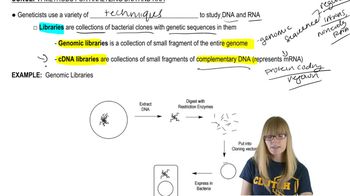How does a positive ASO test for sickle-cell anemia determine that an individual is homozygous recessive for the mutation that causes sickle-cell anemia?
Table of contents
- 1. Introduction to Genetics51m
- 2. Mendel's Laws of Inheritance3h 37m
- 3. Extensions to Mendelian Inheritance2h 41m
- 4. Genetic Mapping and Linkage2h 28m
- 5. Genetics of Bacteria and Viruses1h 21m
- 6. Chromosomal Variation1h 48m
- 7. DNA and Chromosome Structure56m
- 8. DNA Replication1h 10m
- 9. Mitosis and Meiosis1h 34m
- 10. Transcription1h 0m
- 11. Translation58m
- 12. Gene Regulation in Prokaryotes1h 19m
- 13. Gene Regulation in Eukaryotes44m
- 14. Genetic Control of Development44m
- 15. Genomes and Genomics1h 50m
- 16. Transposable Elements47m
- 17. Mutation, Repair, and Recombination1h 6m
- 18. Molecular Genetic Tools19m
- 19. Cancer Genetics29m
- 20. Quantitative Genetics1h 26m
- 21. Population Genetics50m
- 22. Evolutionary Genetics29m
18. Molecular Genetic Tools
Methods for Analyzing DNA
Problem 4a
Textbook Question
You have constructed four different libraries: a genomic library made from DNA isolated from human brain tissue, a genomic library made from DNA isolated from human muscle tissue, a human brain cDNA library, and a human muscle cDNA library.
Which of these would have the greatest diversity of sequences?
 Verified step by step guidance
Verified step by step guidance1
Understand the difference between genomic libraries and cDNA libraries: Genomic libraries contain DNA sequences from the entire genome, including both coding (exons) and non-coding regions (introns, regulatory sequences, etc.). cDNA libraries, on the other hand, are constructed from mRNA and represent only the expressed genes (coding regions) in a specific tissue at a specific time.
Consider the diversity of sequences in genomic libraries: Since genomic libraries include all DNA sequences from the genome, they inherently have greater diversity because they encompass both coding and non-coding regions, regardless of the tissue source.
Evaluate the diversity of sequences in cDNA libraries: cDNA libraries are tissue-specific and only represent the genes actively expressed in that tissue. For example, a brain cDNA library will only contain sequences from genes expressed in brain tissue, which limits its diversity compared to a genomic library.
Compare genomic libraries from different tissues: Genomic libraries made from DNA isolated from human brain tissue and human muscle tissue will have similar diversity because they represent the entire genome, not just tissue-specific expression. The source tissue does not affect the diversity of the genomic library.
Conclude which library has the greatest diversity: The genomic libraries (from either brain or muscle tissue) will have the greatest diversity of sequences because they include the entire genome, whereas cDNA libraries are limited to expressed genes in specific tissues.
 Verified video answer for a similar problem:
Verified video answer for a similar problem:This video solution was recommended by our tutors as helpful for the problem above
Video duration:
3mPlay a video:
Was this helpful?
Key Concepts
Here are the essential concepts you must grasp in order to answer the question correctly.
Genomic Library
A genomic library is a collection of DNA fragments that represent the entire genome of an organism. It includes both coding (exons) and non-coding (introns and regulatory regions) sequences. Since it encompasses all genetic material, a genomic library typically has a high diversity of sequences, reflecting the complete genetic makeup of the source tissue.
Recommended video:
Guided course

Genomics Overview
cDNA Library
A cDNA library is constructed from complementary DNA synthesized from mRNA transcripts. This type of library represents only the expressed genes in a specific tissue at a given time, thus it reflects the functional aspects of the genome. Consequently, a cDNA library has less diversity compared to a genomic library, as it excludes non-coding regions and genes not actively expressed in the tissue.
Recommended video:
Guided course

Methods for Analyzing DNA and RNA
Tissue-Specific Expression
Tissue-specific expression refers to the phenomenon where certain genes are expressed in specific tissues while remaining silent in others. This results in different cDNA libraries from various tissues (like brain and muscle) containing distinct sets of sequences. Therefore, while both genomic libraries have high diversity, the cDNA libraries will show less diversity due to their focus on the genes expressed in the respective tissues.
Recommended video:
Guided course

Penetrance and Expressivity

 7:40m
7:40mWatch next
Master Methods for Analyzing DNA and RNA with a bite sized video explanation from Kylia
Start learningRelated Videos
Related Practice
Textbook Question
434
views
